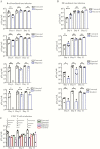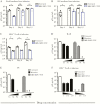Efficient HIV-1 Trans Infection of CD4+ T Cells Occurs in the Presence of Antiretroviral Therapy
- PMID: 31304185
- PMCID: PMC6613953
- DOI: 10.1093/ofid/ofz253
Efficient HIV-1 Trans Infection of CD4+ T Cells Occurs in the Presence of Antiretroviral Therapy
Abstract
Background: Antiretroviral therapy (ART) has dramatically improved the quality of life of people with HIV-1 infection (PWH). However, it is not curative, and interruption of ART results in rapid viral rebound. Cell-to-cell transfer of HIV-1, or trans infection, is a highly efficient mechanism of virus infection of CD4+ T cells by professional antigen-presenting cells (APCs), that is, dendritic cells (DCs), macrophages, and B lymphocytes.
Methods: APC from HIV seronegative donors treated with ART in vitro (CCR5 agonist, NRTI, PI and NNRTI, alone or in combination), were loaded with HIV R5-tropic HIVBal and mixed with autologous or heterologous CD4+ T lymphocytes to assess trans infection. Ex vivo APC from chronic HIV-infected MACS participants before and after initiation of ART, were also loaded with HIV R5-tropic HIVBal and tested for trans infection against autologous or heterologous CD4+ T lymphocytes. Virus replication was measured by p24 ELISA.
Results: Here we show in vitro that antiretroviral drugs did not block the ability of DCs and B cells to trans-infect CD4+ T cells, although they were effective in blocking direct cis infection of CD4+ T cells. Moreover, ex vivo DCs and B cells from ART-suppressed PWH mediated efficient HIV-1 trans infection of CD4+ T cells, which were resistant to direct cis infection.
Conclusions: Our study supports a role for HIV-1 trans infection in maintenance of the HIV-1 reservoir during ART.
Keywords: ART; B lymphocytes; HIV; antigen-presenting cells; dendritic cells; trans infection.
Figures




Similar articles
-
B Lymphocytes, but Not Dendritic Cells, Efficiently HIV-1 Trans Infect Naive CD4+ T Cells: Implications for the Viral Reservoir.mBio. 2021 Mar 9;12(2):e02998-20. doi: 10.1128/mBio.02998-20. mBio. 2021. PMID: 33688006 Free PMC article.
-
Antigen Presenting Cell-Mediated HIV-1 Trans Infection in the Establishment and Maintenance of the Viral Reservoir.Med Res Arch. 2023 Jul;11(7.1):10.18103/mra.v11i7.1.4064. doi: 10.18103/mra.v11i7.1.4064. Epub 2023 Jul 6. Med Res Arch. 2023. PMID: 39634038 Free PMC article.
-
Cholesterol Metabolism in Antigen-Presenting Cells and HIV-1 Trans-Infection of CD4+ T Cells.Viruses. 2023 Nov 29;15(12):2347. doi: 10.3390/v15122347. Viruses. 2023. PMID: 38140588 Free PMC article. Review.
-
Alterations in cholesterol metabolism restrict HIV-1 trans infection in nonprogressors.mBio. 2014 Apr 29;5(3):e01031-13. doi: 10.1128/mBio.01031-13. mBio. 2014. PMID: 24781743 Free PMC article.
-
HIV-1 Trans Infection of CD4(+) T Cells by Professional Antigen Presenting Cells.Scientifica (Cairo). 2013;2013:164203. doi: 10.1155/2013/164203. Epub 2013 May 7. Scientifica (Cairo). 2013. PMID: 24278768 Free PMC article. Review.
Cited by
-
B Lymphocytes, but Not Dendritic Cells, Efficiently HIV-1 Trans Infect Naive CD4+ T Cells: Implications for the Viral Reservoir.mBio. 2021 Mar 9;12(2):e02998-20. doi: 10.1128/mBio.02998-20. mBio. 2021. PMID: 33688006 Free PMC article.
-
Why the HIV Reservoir Never Runs Dry: Clonal Expansion and the Characteristics of HIV-Infected Cells Challenge Strategies to Cure and Control HIV Infection.Viruses. 2021 Dec 14;13(12):2512. doi: 10.3390/v13122512. Viruses. 2021. PMID: 34960781 Free PMC article. Review.
-
Antigen Presenting Cell-Mediated HIV-1 Trans Infection in the Establishment and Maintenance of the Viral Reservoir.Med Res Arch. 2023 Jul;11(7.1):10.18103/mra.v11i7.1.4064. doi: 10.18103/mra.v11i7.1.4064. Epub 2023 Jul 6. Med Res Arch. 2023. PMID: 39634038 Free PMC article.
-
Circumcision as an Intervening Strategy against HIV Acquisition in the Male Genital Tract.Pathogens. 2021 Jun 25;10(7):806. doi: 10.3390/pathogens10070806. Pathogens. 2021. PMID: 34201976 Free PMC article. Review.
-
Cholesterol Metabolism in Antigen-Presenting Cells and HIV-1 Trans-Infection of CD4+ T Cells.Viruses. 2023 Nov 29;15(12):2347. doi: 10.3390/v15122347. Viruses. 2023. PMID: 38140588 Free PMC article. Review.
References
-
- Wong JK, Hezareh M, Günthard HF, et al. . Recovery of replication-competent HIV despite prolonged suppression of plasma viremia. Science 1997; 278:1291–5. - PubMed
-
- Cameron PU, Freudenthal PS, Barker JM, et al. . Dendritic cells exposed to human immunodeficiency virus type-1 transmit a vigorous cytopathic infection to CD4+ T cells. Science 1992; 257:383–7. - PubMed
-
- Geijtenbeek TB, Kwon DS, Torensma R, et al. . DC-SIGN, a dendritic cell-specific HIV-1-binding protein that enhances trans-infection of T cells. Cell 2000; 100:587–97. - PubMed
Grants and funding
LinkOut - more resources
Full Text Sources
Research Materials
Miscellaneous

